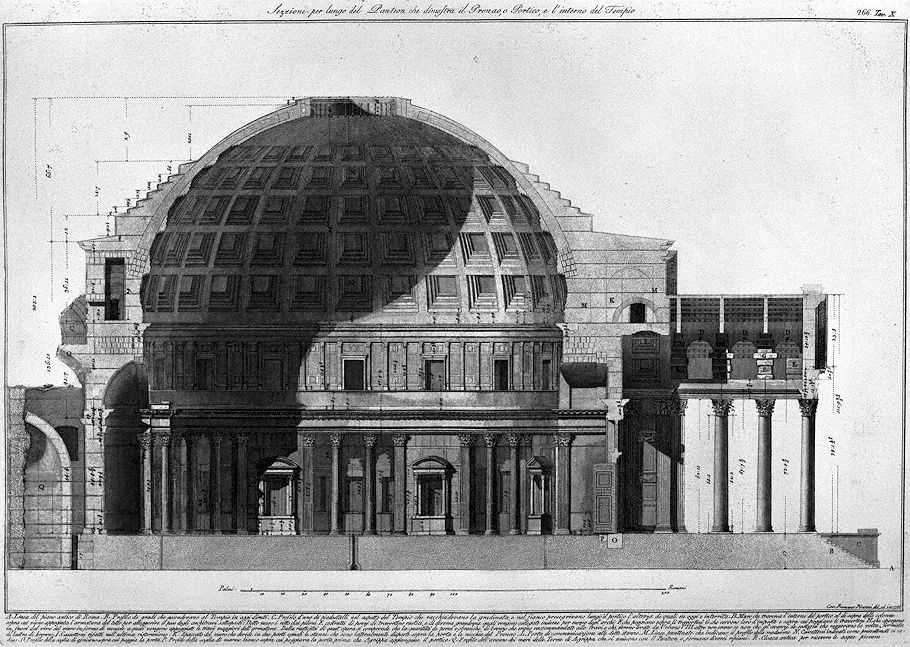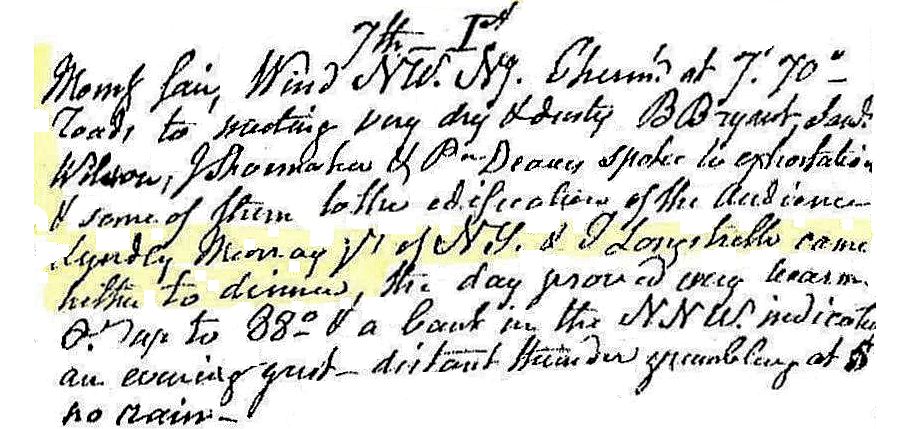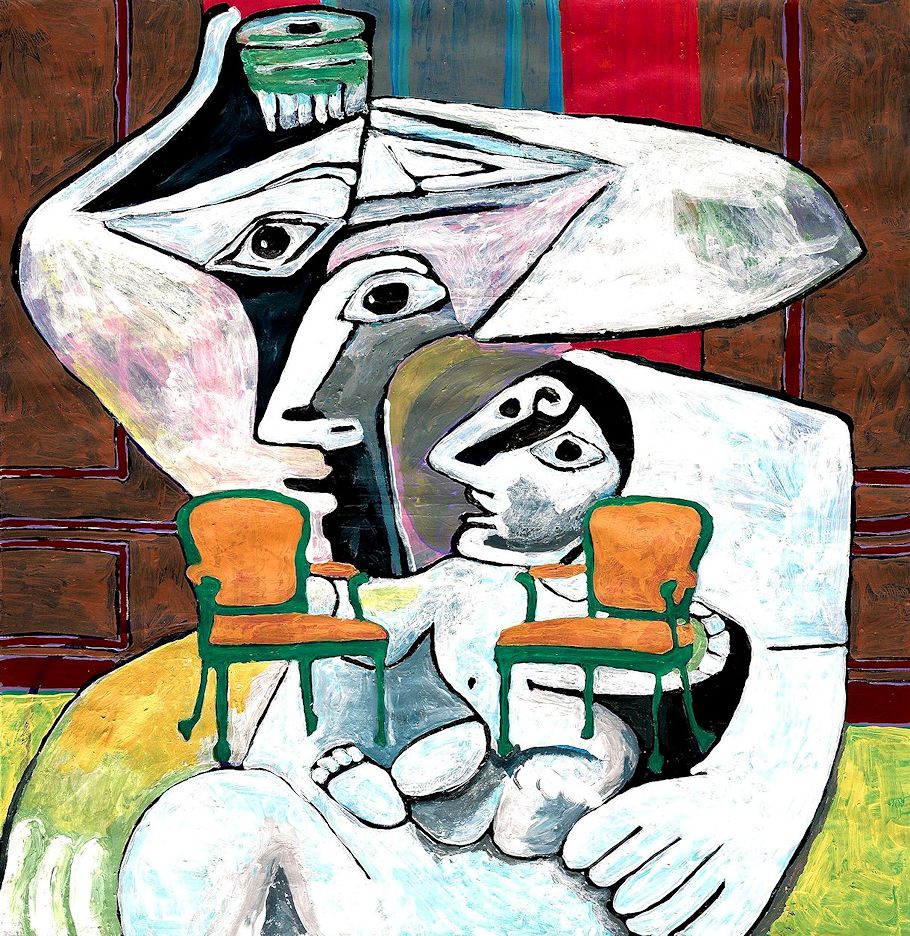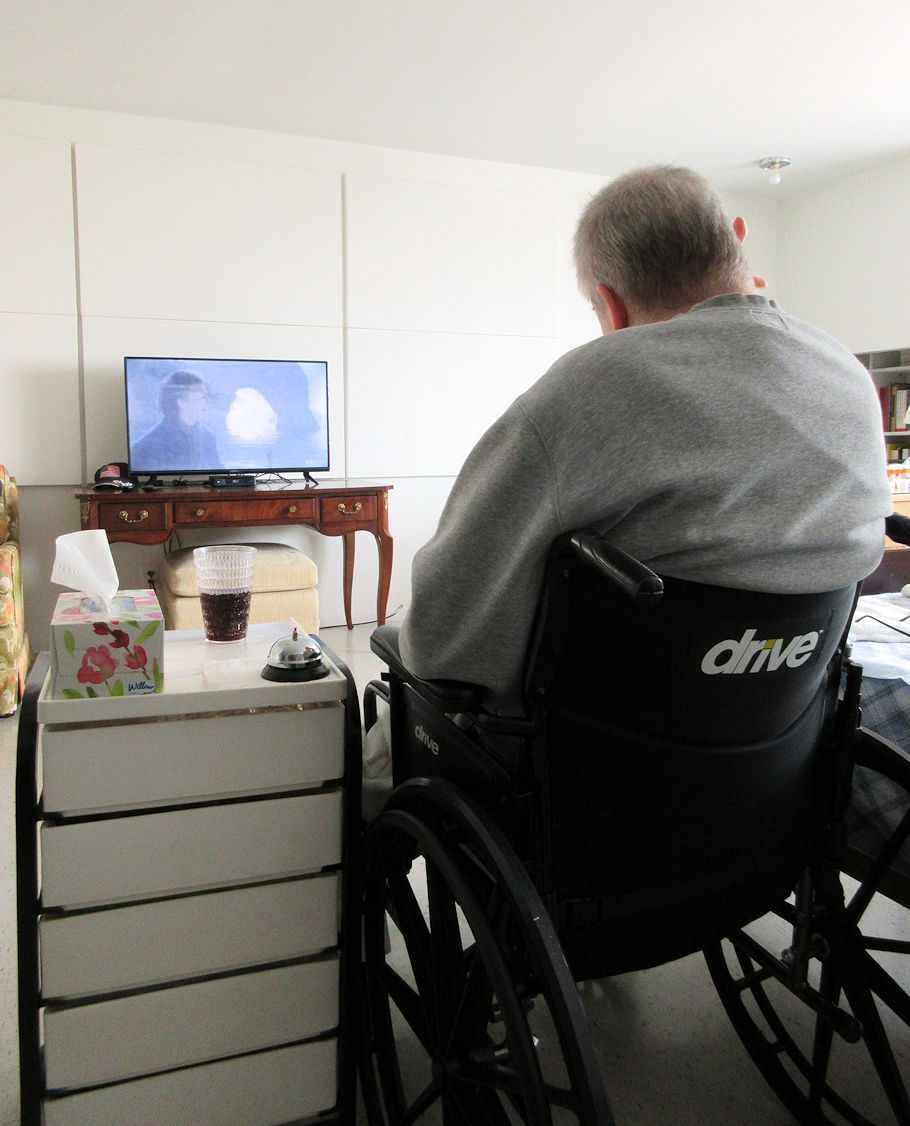7 June 1778 Sunday
. . . . . .
32 y.o. Francesco Piranesi 1 August 1790
Raccolta de'Tempj antichi, Vol. II.

Lengthwise section of the Pantheon showing the Pronaos, or Portico, and the interior of the Temple
A. Line of the ancient plan of Rome. B. Profile of the steps that ascended to the Temple today. C. Profile of one of the pedestals in the aspect of the Temple which enclosed the steps, and in the side they continued along the portico, the height of which is now buried. D. Wall, which crosses the inside of the portico above the columns on which the roof reinforcement is placed to lighten the weight of the underlying architraves; Said wall is supported by pillars E built of rustic travertine pieces of different sizes which are connected together by means of arches F. which rest on travertine G. which serve as imposts and on which travertine H rest. which protrude outwards from the wall in the form of shelves on which the main beams of the armor are supported. From the rusticity of this work it is understood that the quantity of pins or bronze sections which were attached to the beams and which were removed by Urban VIII were nothing other than the remains of the supports which held up the vault made up of bronze plates . I. Chests of drawers redone in the last restaurant. K. Cutaway of the wall that divides the rooms arranged laterally above the door and the niches of the Pronaos into two equal parts. L. Communication door to said rooms. M. Dotted lines indicating the profile of the same N. Casettoni indicated as presently visible. O. Profile of the African threshold above which the door rests. P. Profile of the white marble threshold above which the door rested before Agrippa added the portico. Q. Profile of the remains of the walls of the Baths of Agrippa which join with the Pantheon, and form various shelves. R. Ancient cloaca to receive rainwater
Cav. Francesco Piranesi drawn and engraved 1786
7 June 1812 Sunday

Morning clear, wind NW Nerly, therm. at 7 70°. Roads to Meeting very dry and dusty. B Bryant, Samuel Wilson, J Shoemaker and P.. Deanes[?] spoke to exhortation and some of them to the edification of the audience. Lyndly Murray V[?] of NY and T Longstreth came hither to dinner. The day proved very warm. Temperature up to 88° and a bank in the NNW indicate an evening gust. Distant grumbling at 5, no rain.
7 June 1999
the more real Piranesi-effect
The more real 'Piranesi-effect' of our time is the continual confusion and misinterpretation of Piranesi's Ichnographia Campus Martius by architects, architectural historians, and architectural theorists over the last forty-three years.
Beginning with major factual errors within Vincenzo Fasolo's "The CAMPOMARZIO of G.B. Piranesi," which first appeared in Quaderni dell'Instituto di Storia dell'Architettura, n.15, 1956, Piranesi's large plan of the Campo Marzio has received one misinterpretation after another.
After Fasolo, the Campo Marzio's greatest mis-interpreter is Manfredo Tafuri, who wrote eloquently, albeit incorrectly, about the Campo Marzio in both Architecture and Utopia - Design and Capitalist Development, 1976 and The Sphere and the Labyrinth - Avant-Gardes and Architecture from Piranesi to the 1970s, 1987. Outside of the strictly historical accounts of Piranesi's Campo Marzio printing by John Wilton-Ely in The Mind and Art of Giovanni Battista Piranesi, 1978 and by Jonathan Scott in Piranesi, 1975, Tafuri's texts were the only written interpretations of the Campo Marzio readily available to architectural thinkers throughout most of the [20th] century's last quarter. Tafuri's well respected position as the Director of the Department of History of Architecture at the Instituto Universitario di Architettura in Venice led to an unquestioned acceptance of Tafuri's words regarding the Campo Marzio.
Taking Tafuri's false lead, a string of contemporary architects and/or architectural theorists consistently paraphrase Tafuri's texts, thus further procreating subsequent generations of ill-bred Campo Marzio interpretations. The (architectural) authors and texts are:
Stanley Allen, "Piranesi's Campo Marzio: An Experimental Design" in Assemblage (Cambridge, MA: MIT Press Journals, December, 1989), pp. 71-109.
Jennifer Bloomer, Architecture and the text: the (s)crypts of Joyce and Piranesi (New Haven: Yale University Press, 1993).
Peter Eisenman, "Autonomy and the Avant-Garde" in Autonomy and Ideology: positioning the avant-garde in America (New York: Monacelli Press, 1997), pp. 70-9.
Alex Kreiger, "Between The Cursader's Jerusalem and Piranesi's Rome" in Form, Modernism, and History (Cambridge, MA: Harvard University Graduate School of Design, 1996), pp. 151-164.
Rafael Moneo, "Recent Architectural Paradigms and a Personal Alternative" in Harvard Design Magazine (Summer 1998).
Sanford Kwinter, "Can One Go Beyond Piranesi?" in Eleven Authors in Search of a Building (New York: The Monicelli Press, 1996).
Using the Kwinter quotation, "the effect of unforeseeable complexity that arises from multiple interfering structures blindly pursuing their own clockwork logic," as a case in point, one only has to compare it to the following Tafuri quotation, "The clash of the formal organisms, immersed in a sea of formal fragments, dissolves even the remotest memory of the city as a place of Form," and "the whole organism seems to be a clockwork mechanism," to see that Tafuri's misinterpretations of the Campo Marzio still guide those that do not know better.
Perhaps the Kwinter quotation really defines the 'Tafuri misinterpretation of Piranesi-effect.'
7 June 2020

Mary Boone's 180 hours of community service hours 96 97 98 99 100 101 102 103
7 June 2021

7 June 2022
Re: to Cynthia Davidson re The Discovery of Piranesi's Final Project
Dear Cynthia,
In my last email to you, sent Friday, 3 June, I wrote, “…there simply are no texts that can explain the subject matter.” Well, I’ve since found a short text describing two volumes of plates and explanations that were to be eventually published:
ANCIENT CIRCUSES.
Plans, details and division of the
Circus Maximus,
Caracalla,
Eliogabalo,
Flaminius,
Flora,
Nero,
Salust,
Hadrian, still unpublished.
The Circus of Caracalla [which is what the Circus of Maxentius was mistakenly referred to in Piranesi’s time] being the best preserved, we will give the geometric and perspective details, the various restorations, the bleachers, the enclosure around which the chariot race took place, the boxes intended for the magistrates and the emperors. (The latter often took pleasure in racing themselves, driving a quadriga, four-horse chariot); the enclosure from which the tanks left. Besides the ornaments, etc., the bas-reliefs will also be mentioned, in order to make known more positively the uses and the manners adopted for the race. Curious and interesting work.
A volume containing 120 plates
A volume of explanations.
Although this passage was published in 1804 by Francesco once he and his younger brother Pietro were established in Paris, I firmly believe the words themselves were written by Giovanni Battista Piranesi sometime in the months before his death.
Sincerely,
Steve
7 June 2023 Wednesday
. . . . . .
|